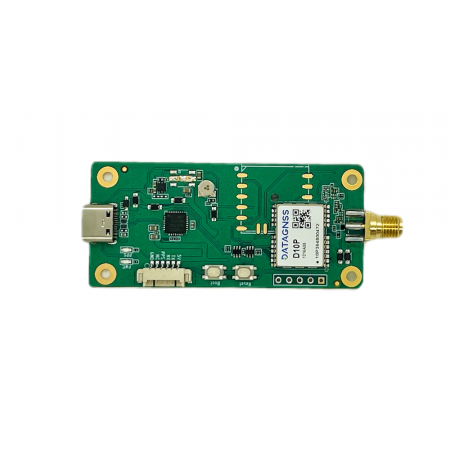Difference between revisions of "TAU951M"
| (12 intermediate revisions by the same user not shown) | |||
| Line 2: | Line 2: | ||
__NOTOC__ | __NOTOC__ | ||
[[File:Tau951m-1216A00.png|thumb|150px|TAU951M, 12*16mm]] | [[File:Tau951m-1216A00.png|thumb|150px|TAU951M, 12*16mm]] | ||
The TAU951M | The TAU951M series is a set of GNSS dual-band high-precision RTK navigation and positioning module which is based on the state of art CYNOSURE IV dual-core SoC chip. <br> | ||
It is capable of tracking all global civil navigation systems (BDS, GPS, GLONASS, Galileo, QZSS, NavIC, and SBAS), as well as BDS-3 signals.<br> | It is capable of tracking all global civil navigation systems (BDS, GPS, GLONASS, Galileo, QZSS, NavIC, and SBAS), as well as BDS-3 signals.<br> | ||
The latest dual-core architecture CYNOSURE IV adopts 22 nm process, with built-in dual-core MCU and 8Mbit MRAM, integrating multi-band multi-system GNSS RF and baseband. <br> | The latest dual-core architecture CYNOSURE IV adopts 22 nm process, with built-in dual-core MCU and 8Mbit MRAM, integrating multi-band multi-system GNSS RF and baseband. <br> | ||
| Line 18: | Line 13: | ||
===Features=== | ===Features=== | ||
*Concurrent reception of multi-band multi-system satellite signals | *Concurrent reception of multi-band multi-system satellite signals | ||
*Support BDS-3 signals: B1C, B2a | *Support BDS-3 signals: B1C, B2a | ||
*Support PPP-B2b/PPP/PPP-RTK (upon request) | *Support PPP-B2b/PPP/PPP-RTK (upon request) | ||
| Line 24: | Line 18: | ||
*Update rate up to 10 Hz | *Update rate up to 10 Hz | ||
*Support A-GNSS | *Support A-GNSS | ||
*Support raw data output(RTCM format) | |||
*Smart jammer detection and suppression | *Smart jammer detection and suppression | ||
| Line 56: | Line 51: | ||
| L1 | | L1 | ||
|- | |- | ||
| style="text-align:left;" | A(default) | | style="text-align:left;" | A<sup>(default)</sup> | ||
| | | • | ||
| | | ○ | ||
| - | | - | ||
| | | • | ||
| - | | - | ||
| | | • | ||
| | | • | ||
| - | | - | ||
| - | | - | ||
| | | • | ||
| - | | - | ||
| | | • | ||
| - | | - | ||
| | | • | ||
| | | • | ||
| - | | - | ||
| - | | - | ||
| | | ○ | ||
| | | • | ||
|- | |- | ||
| style="text-align:left;" | B | | style="text-align:left;" | B | ||
| | | • | ||
| | | ○ | ||
| | | • | ||
| - | | - | ||
| - | | - | ||
| | | • | ||
| | | • | ||
| | | • | ||
| - | | - | ||
| - | | - | ||
| - | | - | ||
| | | • | ||
| | | • | ||
| | | • | ||
| - | | - | ||
| | | • | ||
| - | | - | ||
| - | | - | ||
| | | • | ||
|- | |- | ||
| style="text-align:left;" | C | | style="text-align:left;" | C | ||
| | | • | ||
| | | • | ||
| | | • | ||
| - | | - | ||
| - | | - | ||
| | | • | ||
| | | • | ||
| - | | - | ||
| - | | - | ||
| - | | - | ||
| - | | - | ||
| | | • | ||
| - | | - | ||
| | | • | ||
| - | | - | ||
| - | | - | ||
| - | | - | ||
| - | | - | ||
| | | • | ||
|} | |} | ||
[ | [○] Supported upon request with special firmware | ||
===Specifications=== | ===Specifications=== | ||
| Line 134: | Line 126: | ||
| Constellations | | Constellations | ||
| colspan="3" | BDS, GPS, QZSS, GLONASS, Galileo, NavIC, SBAS | | colspan="3" | BDS, GPS, QZSS, GLONASS, Galileo, NavIC, SBAS | ||
|- | |- | ||
| Update rates | | Update rates | ||
| Line 172: | Line 161: | ||
| >99.9% | | >99.9% | ||
|- | |- | ||
| rowspan="4" | Sensitivity[1] | | rowspan="4" | Sensitivity<sup>[1]<sup> | ||
| colspan="2" | Cold start | | colspan="2" | Cold start | ||
| -148 dBm | | -148 dBm | ||
| Line 188: | Line 177: | ||
| colspan="3" | NMEA-0183 | | colspan="3" | NMEA-0183 | ||
|- | |- | ||
| colspan="3" | RTCM | | colspan="3" | RTCM 3.X, raw measurements | ||
|- | |- | ||
| Baudrate | | Baudrate | ||
| colspan="3" | 115200 bps, by default | | colspan="3" | 115200 or 230400 bps, by default, depend on the firmware | ||
|- | |- | ||
| rowspan="3" | Operating condition | | rowspan="3" | Operating condition | ||
| Line 222: | Line 211: | ||
| 2 | | 2 | ||
|- | |- | ||
| colspan="2" | SPI[2] | | colspan="2" | SPI<sup>[2]</sup> | ||
| 1 | | 1 | ||
|- | |- | ||
| colspan="2" | I2C[2] | | colspan="2" | I2C<sup>[2]</sup> | ||
| 1 | | 1 | ||
|- | |- | ||
| Line 252: | Line 241: | ||
[2] Supported upon request with special firmware | [2] Supported upon request with special firmware | ||
===Related Documents=== | |||
*[[TAU951M_datasheet]] | *[[TAU951M_datasheet]] | ||
*[[Satrack Quickguide]] | *[[Satrack Quickguide]] | ||
*[[Allystar_GNSS_Protocol]] | *[[Allystar_GNSS_Protocol]] | ||
===TEST EVK=== | |||
[[File:D10P-EVK-1.png|frameless|450px|D10P EVK]] | |||
[[Category:Dual-band]] | [[Category:Dual-band]] | ||
[[Category:RTK]] | [[Category:RTK]] | ||
Latest revision as of 10:58, 7 August 2024
TAU951M RTK module
The TAU951M series is a set of GNSS dual-band high-precision RTK navigation and positioning module which is based on the state of art CYNOSURE IV dual-core SoC chip.
It is capable of tracking all global civil navigation systems (BDS, GPS, GLONASS, Galileo, QZSS, NavIC, and SBAS), as well as BDS-3 signals.
The latest dual-core architecture CYNOSURE IV adopts 22 nm process, with built-in dual-core MCU and 8Mbit MRAM, integrating multi-band multi-system GNSS RF and baseband.
This newly designed architecture makes the module achieve centimeter level position accuracy and higher sensitivity,greater for improved jam resistance and multipath,
and provide a highly robust service in complicated environment.
Along with its preeminent performance, the compact size (16.0×12.2×2.4 mm) of TAU951M-P2 series of LCC package with lower consumption makes it suitable for various demands
under different conditions.
It can be widely used in mower, Intelligent transportation, surveying and mapping, unmanned aerial vehicles (UAVs), intelligent agriculture, and other fields.
Features
- Concurrent reception of multi-band multi-system satellite signals
- Support BDS-3 signals: B1C, B2a
- Support PPP-B2b/PPP/PPP-RTK (upon request)
- Internal PVT, RTD, and RTK Engine
- Update rate up to 10 Hz
- Support A-GNSS
- Support raw data output(RTCM format)
- Smart jammer detection and suppression
| Mode | GPS/QZS | BDS | GLONASS | GALILEO | NavIC | SBAS | |||||||||||||
|---|---|---|---|---|---|---|---|---|---|---|---|---|---|---|---|---|---|---|---|
| L1CA | L1C | L2C | L5 | L6 | B1I | B1C | B2I | B2b | B2a | B3I | G1 | G2 | E1 | E5a | E5b | E6 | L5 | L1 | |
| A(default) | • | ○ | - | • | - | • | • | - | - | • | - | • | - | • | • | - | - | ○ | • |
| B | • | ○ | • | - | - | • | • | • | - | - | - | • | • | • | - | • | - | - | • |
| C | • | • | • | - | - | • | • | - | - | - | - | • | - | • | - | - | - | - | • |
[○] Supported upon request with special firmware
Specifications
| Parameter | Specifications | ||
|---|---|---|---|
| Constellations | BDS, GPS, QZSS, GLONASS, Galileo, NavIC, SBAS | ||
| Update rates | 10Hz | ||
| Position accuracy | GNSS | 1.0m CEP | |
| SBAS | <1.0m CEP | ||
| RTK | 1.0 cm + 1 ppm (H) 2.0 cm + 1 ppm (V) | ||
| Velocity & Time accuracy | GNSS | 0.05 m/s CEP | |
| 1PPS | 20ns RMS | ||
| TTFF | Hot start | 1s | |
| Cold start | 27s | ||
| RTK | Convergence time | <10s | |
| Reliability | >99.9% | ||
| Sensitivity[1] | Cold start | -148 dBm | |
| Hot start | -155 dBm | ||
| Reacquisition | -158 dBm | ||
| Tracking & navigation | -165 dBm | ||
| Protocol | NMEA-0183 | ||
| RTCM 3.X, raw measurements | |||
| Baudrate | 115200 or 230400 bps, by default, depend on the firmware | ||
| Operating condition | Main supply | 1.75V to 3.63V | |
| Digital I/O supply | 1.75V to 3.63V | ||
| Backup supply | 1.62V to 3.63V | ||
| Power consumption | Tracking | GNSS | 30 mA @ 3.3V |
| Single system | 18 mA @ 3.3V | ||
| Standby | Data backup | 16 uA | |
| RTC | 1.4 uA | ||
| Serial interface | UART | 2 | |
| SPI[2] | 1 | ||
| I2C[2] | 1 | ||
| Operating limit | Velocity | 515 m/s | |
| Altitude | 18,000m | ||
| Environmental conditions | Operating temp. | -40°C to +85°C | |
| Storage temp. | -40°C to +90°C | ||
| Humidity | 95% RH | ||
| Size | 16.0×12.2×2.4 mm, 24pin LCC | ||
[1] tested with a good external LNA
[2] Supported upon request with special firmware

